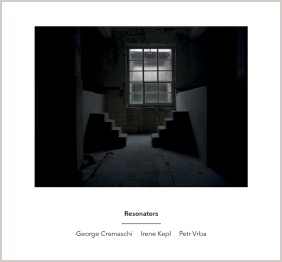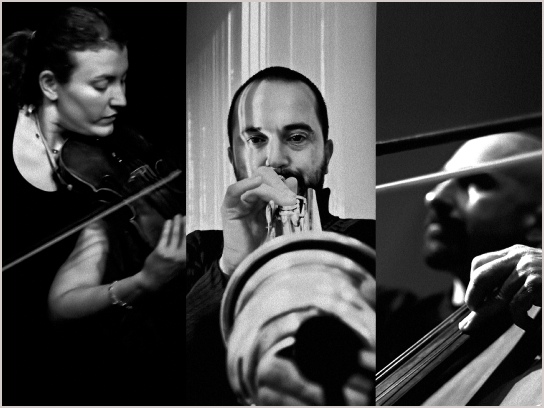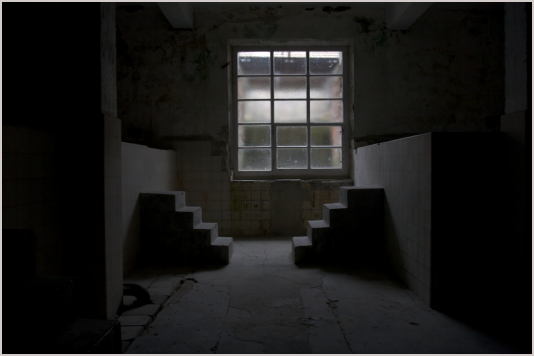Another Timbre TimHarrisonbre

at104 Resonators
George Cremaschi - double bass & electronics
Irene Kepl - violin & electronics
Petr Vrba - trumpet, clarinet & electronics
1 - George Cremaschi ‘Affective Labor’ 13:21 Youtube extract
2 - Irene Kepl ‘Soma’ 6:05
3 - Petr Vrba ‘Locus Resonatus’ 13:13
4 - Irene Kepl ‘Pirol’ 4:08
Acoustic instruments and feedback devices in unusually resonant old stone buildings.
Recorded during a residency in the Czech Republic in 2015
Interview with George Cremaschi, Irene Kepl & Petr Vrba
Could you tell us how the Resonators project came about, and what its aims are?
George: Irene initially invited us together to make a proposal for a concert series in a Viennese church which has good acoustics, so we submitted a plan for working with the particular architecture and sound of the space. It ended up working well and so we continued. Overall we're concerned with using the acoustics of the resonant spaces we seek out as a sort of additional member of the group, composing with this interaction particularly in mind. For myself the aim is to continue to develop my work with amplification and feedback in highly reverberant spaces, which has been ongoing for some time.
Irene: George, Petr and I had experience together individually but so far we hadn’t played together as a group. I thought it could be nice to work together because our approach seemed to be similar. I had started to work with feedback at that time, so we all had both acoustic instruments and feedback/electronic devices. The music is not about showing or performing architecture, it's about focusing on the inside of sound in relation to the space and working it naturally into something that is perhaps more like a sound installation. I appreciate the playful approach that Petr, George and I share, combined with being really serious and open about what we're exploring, leaving enough space to let the sound evolve in the room.
So what rooms or spaces did the trio choose to work with?
Petr: For the series of Czech concerts where these recordings were made, there was a small church, two monasteries, and a hall in the former summer palace of a royal family – all dating back several hundred years. While age is not necessarily a prerequisite for good acoustic conditions, there is something special about how sound reacts in old stone structures.
The resonance of each kind of space will have its own characteristics, and this is especially critical with feedback which can easily become harsh and distorted, all the more so when multiple instruments are involved. In the monasteries we used the ambit, the large square hallway adjoining the church, which proved to have a quite special sound. The long hallways, open through arches to the central courtyard, amplified the sound but also allowed it to breathe.
What did the audience make of the concerts?
George: The nature of the audiences was quite diverse – the concerts in Prague and Vienna were attended by a more 'inside' audience, and were well-received. The other concerts were in smaller towns, and as such had a perhaps less knowledgeable audience, but they were equally well-received, especially in the monasteries where we invited the attendees to wander around the halls and courtyard and treat the event as more of an installation. This worked really well, especially with older folks who initially thought they were attending a classical music concert, and with a large group of theatre students who happened to show up at one performance and afterward were super enthusiastic.
George, as an American, how do you come to be in the Czech Republic?
George: My relationship with the Czech Republic goes back to the late 90s, when I first came to visit some friends from California who had started an arts residency/cultural centre in a small town south of Prague. I quickly fell in love with the place – both the centre and the town – and started coming back every summer to work and curate at the centre and also to play concerts around Europe. Over time I was working more in Europe than the US, at least in terms of being paid decently as a musician, and as the endless state of war asserted itself in the US along with the rising cost of living and dwindling artistic opportunities of the places I'd be willing to live in such as New York or San Francisco, the choice to live in Czech/EU just became obvious. One major attraction is directly related to this recording: the abundance of fantastic spaces to play in central Europe, old churches and monasteries that hardly exist in the US, where the average place to play has little to do with fine acoustics.
I know that you are all involved with improvisation, but the pieces on the CD are attributed to one or other of you as composed works. There’s obviously a huge grey area between composition and improvisation, but where did your pieces fit on this spectrum, and how did they work?
George: Yes, there is quite a large grey area, and our pieces fit across much of it. Mine is somewhere in the middle – there is a very specific feel I want from it, and there are quite a lot of written instructions, and even specific timed entrances and overall length. Given how the word 'improvisation' has evolved, I wouldn't say that there's really much, but still there is a lot of room for manoeuvring for the individual players. On the other side, Petr's piece is quite fixed. His part is completely notated, and within a specific time structure Irene and I are required to play more or less consonant notes which we arranged ahead of time. There is some flexibility with entrances and dynamics but within a fairly narrow range.
Irene: At the very beginning, instead of "just" improvising, we ended up discussing some musical ideas. So some kind of composing seemed to be the right way for us to explore our music. It allowed us to go deeper, developing the ideas of each of us in a more focused way. Anyway, our aim wasn’t to play in the most “correct” way, it felt more like everyone was directly involved in bringing each other’s pieces into the world with their own musical input, helping with an unbiased and open mind. That’s what I personally really enjoyed.
In fact I composed a piece for the first performance in Vienna – Gamma – which works with pictures, structures and layers, and it was very strictly organized. For the tour I decided to create new pieces in a more open way, using structures, gestures and their relations. It allowed us to make more autonomous decisions in playing in a way that challenged and highlighted our individual musical languages and relations with one special focus: the silence and the room. So there are quite a few aspects to think about, but actually this is quite an open form of composition.
Reviews
“Here’s another release from the ever dependable Another Timbre, arriving in a sombre white, card wallet, adorned with a cryptically beautiful photograph of a windowed room. The album has four tracks, two longer pieces which outlast 13 minutes, and two shorter, at four and six minutes. The trio divide up thusly: Cremaschi on double bass, Kepl on violin, and Vrba on trumpet and clarinet. Each also plays the mysterious ‘and electronics’ - it would be nice to have these devices or set-ups further elaborated, but they do remain a mystery. The tracks were recorded in a monastery, and hall, both in Czech Republic, so (as is often a feature of Another Timbre releases) we are listening to the space as much as to the musicians.
The first piece, Affective Labor, credited to Cremaschi, is a monstrous start to the album. It’s 13 minutes of drifting - yet strong - feedback, drones, and hums, with the acoustic instruments poking through from time to time. The beautifully blurry bass drones, and arcing lines of feedback, border on noisiness at points. It’s really not that far from an incredibly complex and deep piece of dark ambient music. Around the ten minute mark, the work explodes with outbursts of chirruping clarinet, and strong violin, before dissipating just as quickly. Whilst there is a general sense of purity, and ‘cleanliness’ about the overall sound, throughout the piece there are background noises and thuds, which stop it from becoming sterile. Soma, the second track - credited to Kepl - begins quite differently, with smaller, more articulate sounds and playing. However, soon enough, large bassy monoliths appear. It’s a much more shifting, dynamic work than Affective Labor, with distinct sections and separated ideas. It jumps from quiet to loud in seconds, and for the most part maintains a violence, without recourse to simple noise - often through frenzied or very hard scraping, or blowing.
The third track, Locus Resonatus (assigned to Vrba), is somewhat different from the start. Simple, long notes from the clarinet are slowly complimented and built upon, until a heavy classical drone is constructed. Built out of several interlocking layers, this rich and colourful piece seems to get progressively more and more intense. With straining, high violin notes, and almost martial trumpet calls, the track seems to be much more than the result of a mere three people. Complimenting this, is the fourth and final track, Pirol; it’s the shortest effort at 4:08, and like Soma is credited to Irene Kepl. Like the aforementioned Soma, Pirol is a dynamic piece, that is perhaps less concerned with playing the performance space than Affective Labor. To put things another way, there is more emphasis on the musicians interacting with each other, rather than explicitly with the space they find themselves in - though, of course, the space is not removed from this equation. Pirol’s most striking elements are the contrasting of straight, held trumpet notes with thuggish slams from the double bass - the latter punctuating the former with visceral abandon. Though the track also notably contains various micro-sounds, bubbling, scraping, and burbling.
This is a very fine set of recordings, which compliment each other very nicely, and in doing so cover a lot of ground. The trio really do dissolve into each other at points, creating a true sense of selfless, group playing. I must admit that whilst I really enjoyed the first track, Affective Labor (which, let’s be clear, is quite staggering), I also suspected that the rest of the album might follow in it’s footsteps - but Resonators doesn’t. Instead, the remaining three pieces carve out different spaces and sound-worlds (though Soma and Pirol are undoubtedly similar), and show different sides of the grouping. A very recommended release.”
Roger Batty, Musique Machine
“En 2014, on avait entendu Petr Vrba et George Cremaschi improviser sous le nom de Los Amargados – sur l’une des deux faces d’El dia de los Amargados (cassette autoproduite par Vrba sous étiquette Unusual), la clarinettiste Susanna Gartmayer rejoignait le duo. Avec la violoniste Irene Kepl – qui, à l’origine de l’association qui nous intéresse, invita ses acolytes à jouer avec elle dans une église de Vienne –, le trompettiste et le contrebassiste servaient récemment Resonators, un projet qui impose à trois instruments acoustiques amplifiés et à un peu d’électronique de « faire résonner » l’architecture. Celle du monastère de Bechyně, République Tchèque, par exemple, où se sont arrê- tés les musiciens le 7 juin 2015 dans le cadre d’une courte tournée. Une composition chacun : voilà le matériau sur lequel ceux-là s’accordent et, même, malgré des méthodes d’écriture différentes, s’entendent. Trompette, clarinette, cordes et archets, lissent ainsi des notes que les pierres leur renverront bientôt. A chaque fois, le retour vers le musicien du premier signal le force à la décision : nouvelle intervention, atténuation de la résonance ou silence ? Souvent, les gestes sont déliés – à l’image de ceux de la violoniste, enregistrés deux jours plus tôt, à la loggia Valdstejn à Jičín (c’est la quatrième plage) – mais peuvent aussi concourir : jusqu’à Locus Resonatus, composition de Vrba aux airs de grand vaisseau qui chavire. C’est là, en conséquence, qu’on dénichera l’onction la plus pénétrante.”
Guillaume Belhomme, Le Son du Grisli
“ Hintergrund dieser Aufnahmen aus den tschechischen Ortschaften Bechyně und Jičin war die Ambition, für elektronisch verstärkte Instrumente zu komponieren. Daraus ergibt sich auch zwangsläufig der Name dieses Resonators-Projekts. Es ist ein stilles, unaufgeregtes Musizieren, dass Cremaschi, Kepl & Vrba kultivieren, die elektroakustische Balance droht dabei niemals, verlustig zu gehen. Man lässt sich unterschiedlich viel Zeit zur Entwicklung des Wegs von der Idee zur Umsetzung, Kepl genügen durchschnittlich fünf, Cremaschi und Vrba pendeln sich bei 13 Minuten Spielzeit ein. Vordergründig passiert wenig auf dem genannten Weg, unter der stillen Oberfläche aber brodelt die Inspiration. Eher verhält es sich so, dass eben der Verzicht auf Action zugunsten des langen Atems dieser Veröffentlichung den Glanz und den Beweis ihrer Notwendigkeit verschafft.”
(Felix)

Resonators: Irene Kepl, Petr Vrba & George Cremaschi

Photograph: Matthias Halibrand
More Reviews
“Aural feedback is a funny thing: it can be a nightmare or provide an interesting effect to a performance. Bad: a mic turned up too loud at a pulpit, or high school assembly, or by the inexperienced sound man at your gig; it is a brief ear (drum) piercing shock that causes gasps and cannot be ignored. On the other hand, a guitarist manipulating a cool overtone cloud by leaning on an amp is as satisfying as a purring cat.
George Cremaschi (bass and electronics), Irene Kepl (violin and electronics) and Petr Vrba (clarinet and electronics) creatively work in the latter realm, except the "amp" that provides an amplified controlled chaos comes from the acoustics in monasteries and palatial halls.
"Affective Labor" is the group's Frankenstein gradually (!) coming to life and taking first steps (or mythical sea monster awakening and heading for shore, or a cell experiencing mitosis). The occasional deep-note pluck by Cremaschi is surrounded by wispy warbles and flickering-but-muted soundwaves. This texture swells and builds and gives way to lower frequency rumbles, and Kepl playing the first "notes," which consist of brief pizzicato bursts, sporadic glissandi and delicate single-string accelerando / decelerando. As far as the resonance surrounding the trio (much of it hand-coaxed in real-time), Cremaschi has mentioned that the performance spaces become "a sort of additional member" during the works. This becomes evident near the 9:30 mark where, with the aid of the players, this "member" overtakes the acoustic instruments in a frenzy of snarls and howls.
The thirteen-minute "Locus Resonatus" begins with a temperate clarinet solo from Vrba that evokes the somber nature of Messiaen's Abime Des Oiseaux (third movement of Quatuor pour la fin du temps). Soon the lines begin to double and loop, phasing and woozy when unison, spider-like and expansive when contrapuntal. Vrba and Cremaschi join to muster a slowly beating cluster — one that sounds much bigger than something spawned by only three people — that almost comes into harmonic focus at various points throughout. But that would be boring. Instead, the band continues to introduce more and more elements to revel in a lovely so-called dissonance.
The relatively aggressive finale, "Pirol," is largely absent of the electronic influence heard on the previous set. Instead, Cremaschi taps, pounds, and furiously bows, Kepl plays a virtuosic flurry of bursts, and Vrba spends time switching between boisterous exhaled breaths and dynamic trumpet surges. The group works interdependently without following many cues from one another, but at times hands each other the baton. And after one mammoth string snap, they're done.”
Dave Madden, The Squid’s Ear
“Resonators, released late last year, is a trio recording with Kepl on violin and electronics, George Cremaschi on double bass and electronics, and Petr Vrba on clarinet, trumpet, and electronics. As the title implies, the recording was made with the acoustics of the performance environment foremost in mind; the four pieces on the CD were recorded in two particularly resonant spaces in the Czech Republic. In order to fully exploit the natural resonance of the spaces, the acoustic instruments were fortified with amplification and feedback. Feedback dominates the first track, Cremaschi’s Affective Labor, which conveys a sense of sounds drifting in an expansive space. Kepl’s two compositions stand in pronounced contrast to each other, Soma focusing on timbral variability through bow articulation and slow counterpoint, and Pirol collecting brief, frenetic fragments of pitches and sounds. Pirol’s scattering of quick sounds is quite a different thing from the piece that precedes it, Vrba’s gravely beautiful Locus Resonatus. Here strata of long, overlaid tones create ambiguous harmonies that slowly accumulate tension as the dynamics build to a very gradual crescendo. The richness of the acoustic instruments comes through most clearly, helped along by Vrba’s switch from clarinet to trumpet as the piece unfolds.”
Avant Music News